It’s May in full-tilt, and (unbelievably already) time to post this month’s canjam double-header creation.
Though the situation was ripe—like this season’s bounties of asparagus and rhubarb—this is the first month in a while that I haven’t lived up to my Two-batch Kick-ass ninja name. (Maybe it’s because I didn’t make jam?)
Really, my single-batch-mindedness was the result of finances. I could only afford to buy two bundles of asparagus at my co-op.
I’ve lived for three months on less income than I thought ever possible (book contracts take a long time), so thriftiness is at the forefront of my priorities. What’s truly ripe is the opportunity to dig in to Eugenia Bone’s Kitchen Ecosystem idea and a little ol’ fashioned depression-era thinking.
I can’t wait for our (very first!) CSA farm share to start up at the end of the month; I have yet to can anything in the midst of real over-abundance.
Aspara-gusto Project
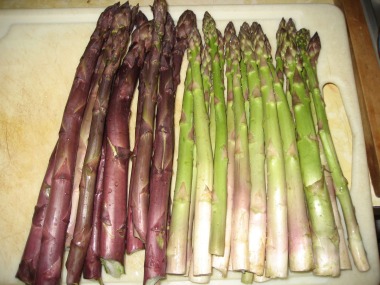 Start: 2lbs 4oz. of asparagus (that’s two rubber-banded bundles, one purple, the other green; one organic, both local) cost: $9.05
Start: 2lbs 4oz. of asparagus (that’s two rubber-banded bundles, one purple, the other green; one organic, both local) cost: $9.05
Objectives: As many additions/utilities to my kitchen ecosystem as possible, minimal wastes, at least one jar of waterbath canned pickles for the Tigress Can Jam.
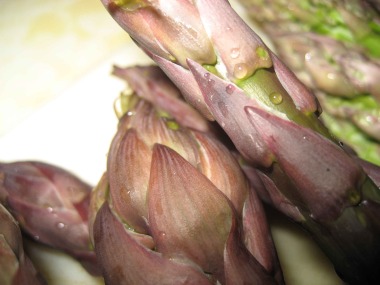 1. FRESH. Duh. Why do I always forget to do this? In the frenzy of small-batch putting up, I forget that the best way to eat anything is fresh. What a funny thing to forget to do: enjoy season’s bounty before putting it by.
1. FRESH. Duh. Why do I always forget to do this? In the frenzy of small-batch putting up, I forget that the best way to eat anything is fresh. What a funny thing to forget to do: enjoy season’s bounty before putting it by.
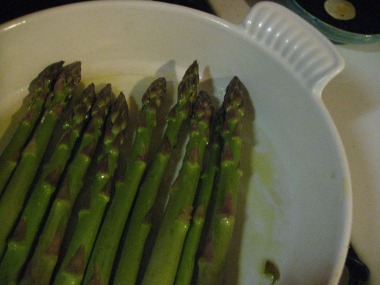 Appearing in my Julia Child, Le Creuset dish, found for $10 at the Bklyn Flea.Anyhow, a small handful tossed with a little olive oil, and garlic then roasted in the oven set the stage for a perfect evening of asparagus action.
Appearing in my Julia Child, Le Creuset dish, found for $10 at the Bklyn Flea.Anyhow, a small handful tossed with a little olive oil, and garlic then roasted in the oven set the stage for a perfect evening of asparagus action.
2. PICKLED. I consulted Linda Ziedrich’s and Eugenia Bone’s books, The Joy of Pickling and Well-Preserved, respectively.
I ended up with a Zied-Bone conglomerate recipe, since I liked aspects of both. I had to whip out the calculator and divide it down for such a small yield:
yield 1 pint
~1 lb asparagus, or as many stalks as you can cram into a pint jar (plus 4 or 5; they shrink in the blanching process!)
3/4 cup white wine vinegar
3/4 cup water
1 Tbs pickling salt (I used Kosher; read either of the aforementioned books to understand how to use it in place of pickling salt)
3/4 Tbs sugar
1 clove garlic (sliced long-way into 4 or 5 pieces)
1 tsp whole peppercorns
2 seed pods’ worth of cardamom (total experiment!) —>interesting, but not repeatworthy
1 dried red pepper (seed flakes included)
This is a fresh pickle (i.e. not fermented) so I followed what appears to be the basic pickle protocol. Blanch the asparagus: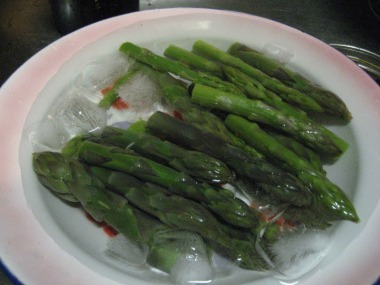 Combine liquids in a non-reactive pot with salt, sugar, garlic and spices. Bring to boil and then remove from heat.
Combine liquids in a non-reactive pot with salt, sugar, garlic and spices. Bring to boil and then remove from heat.
Drop the dried red pepper in your sterilized pint jar and pack asparagus into the jar tightly (so no stalks float to the top when the vinegar is poured in.) Eugenia says top up; Linda says either way. I opted for top down so they’re easier to pull out.
Pour vinegar mixture over crammed asparagus leaving 1/2 inch from the top rim of the jar.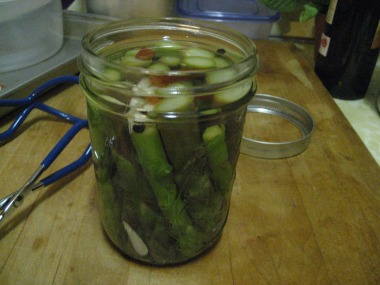 Throw the simmered, appropriately warmed and gummy-rimmed lid on and process for 10 minutes in waterbath canner.
Throw the simmered, appropriately warmed and gummy-rimmed lid on and process for 10 minutes in waterbath canner.
I’ll tell you how delicious they are in three weeks.
Oh, wait. The night’s not over in asparagus economy-land.
3. SOUP, cream of. Well, here’s the deal. I used the mid-sections (the areas just below the tip sections that I pickled) and sauteed them with an onion, garlic and pat of butter until soft.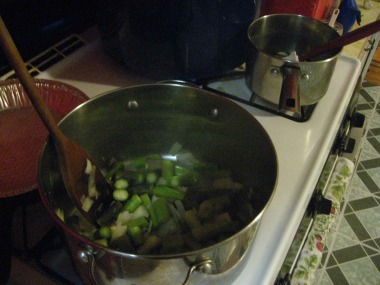
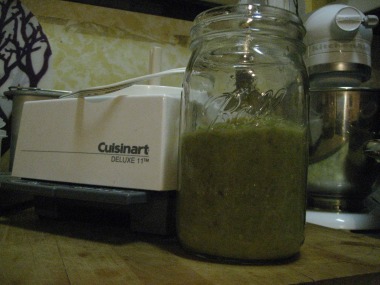 Then I added enough stock (home-frozen and thawed, something I already had in my kitchen ecosystem!) to make the sauteed veg creamy in the mighty food processor.
Then I added enough stock (home-frozen and thawed, something I already had in my kitchen ecosystem!) to make the sauteed veg creamy in the mighty food processor.
Ideally you’d make the soup the night or day of your pickling and avoid all these crazy steps. I was waiting for my J to come home from DC, though. So I made an asparagus soup concentrate where I’d just have to add stock, milk and salt to taste. Recipe inspired by The Joy of Cooking, with liberties taken to spread the process out until I was ready to make it two days later.
Results: lunch for two and dinner for one. Slurp.
4. STOCK using the very ends of the stalks, the last inch or so that’s not useful for anything besides compost. I also threw in the onion scraps (from the soup) and a few chicken bones I’d stashed in the freezer until I had enough for a stock.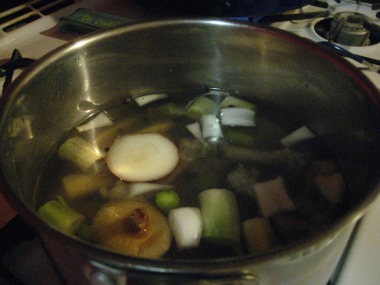 I boiled it long and low, a little too long, in fact. I ended up with a super-condensed veg-chicken stock combo.
I boiled it long and low, a little too long, in fact. I ended up with a super-condensed veg-chicken stock combo.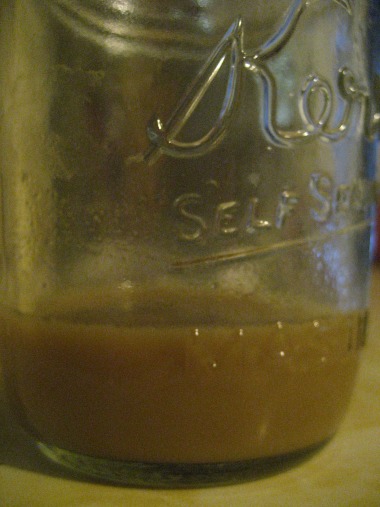 Which was cool. When using it in a dish, I’d just add extra water since this flavor-packed, home-simmered stock is the equivalent of a bouillon cube (without all the gross shit they put in those.)
Which was cool. When using it in a dish, I’d just add extra water since this flavor-packed, home-simmered stock is the equivalent of a bouillon cube (without all the gross shit they put in those.)
5. HYDRATE. Canner pot water to garden (after it’s cooled for a day.) The lobster pot canner volume filled my two watering cans perfectly. My strawberries appreciated the drink.
 Kate
Kate